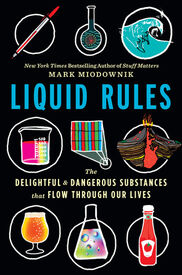Liquid Rules

The Delightful and Dangerous Substances That Flow Through Our Lives
by Mark Miodownik
Completed: September 26, 2021- Tech
- 256 pages
- ISBN: 9780544850194
- Goodreads page
This was another delightful little book. See this author’s other book: Stuff Matters. I expected to like this book less than the other one, since I prefer reading about things like concrete and steel and glass, etc. However, I was quite pleasantly surprised by this one. I think this one is actually better written, even if the subject matter may sometimes not be quite as interesting as the one on materials to someone like me. Stuff Matters had quite a few misses unfortunately, while this one doesn’t have many misses.
The basic setting of the book - the author takes a flight from London to San Francisco and discusses various liquids that one encounters - to be a bit too contrived and tried too hard to be an appealing story for the lay reader. I don’t think it worked. However, I think that’s a small price to pay for the overall content of the book.
The liquids covered include kerosene, alcohol, water (I loved this chapter), glues and paints, liquid crystals, saliva and bodily fluids (yeah…), tea and coffee, soap and detergents, coolants (used in refrigerators and air conditioners for example), epoxies, ink, clouds, tar, the earth’s mantle etc.
Some excerpts:
An example of a technical explanation I liked:
Refrigerators work by pumping liquids through a series of pipes contained within them. If the temperature in them is warner than the boiling point of the liquids, they boil. Boiling requires input of energy to break the bonds between the molecules in the liquid (called latent heat), and this heat is taken from the air inside the fridge, cooling it down. Thus the need for low-boiling-point liquids: they need to boil at the temperature inside a fridge, around 40F. But for a fluid to be really useful in a fridge, you need to be able to turn it back into a liquid again by compressing it, using a pump.
In order to compress a gas into a liquid, you have to remove all of the latent heat from it - essentially, the heat is squeezed out of the gas. This happens at the back of a fridge - when the compressor is running, you can hear it; it is that hum that your fridge intermittently emits.
Trivia such as:
P&G invented Ivory soap and invested large sums in marketing it across the whole country, placing ads in national newspapers and magazines. Then, with the invention of the radio in the 1920s, P&G started sponsoring serial dramas. Their audience was mostly made up of women, alone at home during the day, washing clothes and doing house-cleaning; these popular dramas came to be known by a term related to the product whose manufacturer sponsored them - “soap operas.”
All book cover images are from Goodreads unless specified otherwise.